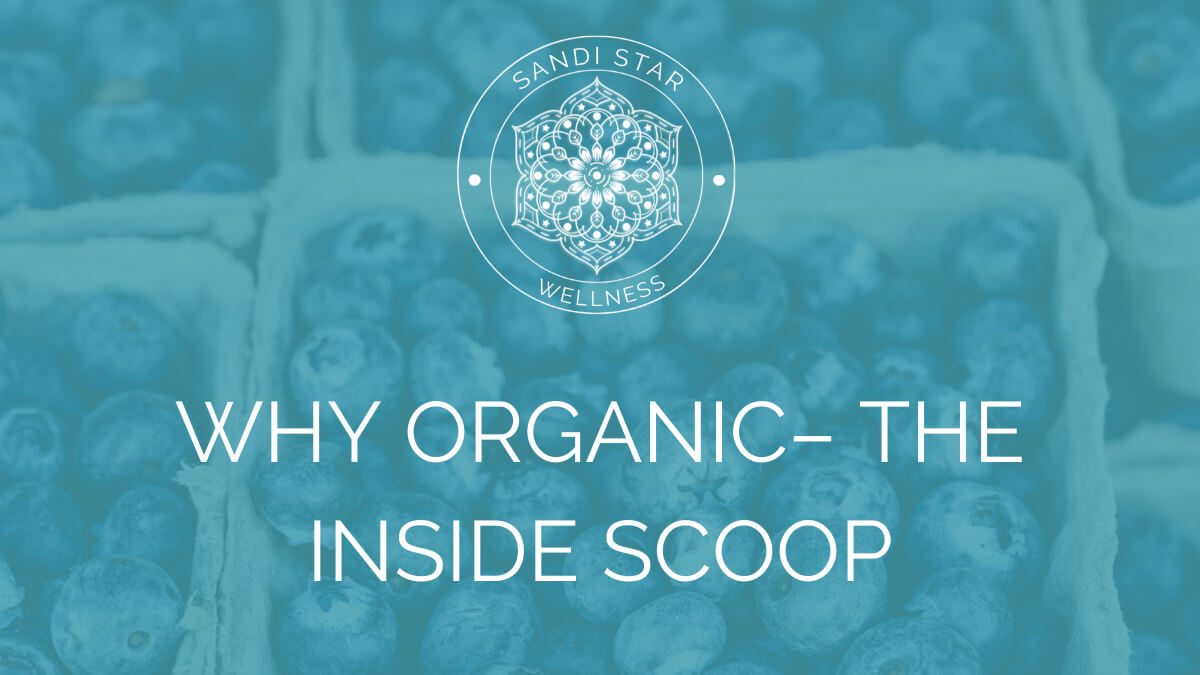
26 Jan Why Organic – The Inside Scoop
I’ve been eating and recommending organic foods for some time now but I’ve never done an article on it until now. It’s important to know why we would go to the store and pay almost double at times for our food so we can justify our commitment to preventative medicine; which by the way is what food is supposed to be. Pay for your health now or pay later is what I tell my patients. Our food needs to be our medicine because good nutrition is what makes our body thrive. I don’t think enough people are questioning where their food comes from or have an understanding about the toxic affects Monsanto has on our foods. This is about awareness and a deep commitment to disease prevention.
I heard a story the other night which was quite disturbing in regards to organic farming. Someone told me in a meeting, a farmer she knew had said they are allowed to use “Roundup” on organic produce. I find that hard to believe and deep down I knew that could not be true so I did my research. I got in touch with a lady I’ve known for some time now, who has been an organic inspector for the past 9 years and is very committed to health and wellness. She helped me find reputable resources for research. She agreed that round up is a toxic chemical not allowed anywhere near organic farming.
PESTICIDES IS AN ESTIMATED $35 BILLION INDUSTRY ACCOUNTING FOR MORE THAN 2.5 MILLION TONS OF CHEMICALS DEPOSITED INTO THE ENVIRONMENT ANNUALLY
Have you ever wondered why it’s important to buy organic meats in addition to fruits and vegetables? When it comes to round up remember non-organic animals are fed grains and foods that are sprayed with round up and we are eating what they ate as it’s in the muscle. Cows are rapidly fattened up with grain-based feeds, usually made with a base of soy or corn. The conventionally raised cows are often given drugs and hormones to grow faster, as well as antibiotics to survive the unsanitary living conditions. The cows live there for a few months and are then moved into the factory for slaughtering. That is not natural. Cows are meant to eat grass which gives them a lot of Omega’s in the meat whereas cows fed grains cause inflammation in our body. Big difference.
There are new antibiotic rules for 2017 you might have seen coming down the pipe and worth a further look. What it basically means is farmers are required to work with a Veterinarian in regards to treating their livestock with antibiotics. Antibiotics and hormones are a serious issue with the meat industry because farmers are now getting them without a prescription. Even with that, we have to question the integrity and expertise of each veterinarian who works with the farmer and hope they use these drugs only when necessary. Remember, antibiotics are prohibited in organic farming. Organic Farmers take care of the environment by allowing the cows to graze in fields as opposed to keeping them confined where disease can easily spread.
I urge you to download the presentations in the link below. Some of the slides are disturbing but well worth the education.
The National Organic Program (NOP) develops the rules & regulations for the production, handling, labeling, and enforcement of all USDA organic products. This process, referred to as rule making, involves input from the National Organic Standards Board (a Federal Advisory Committee made up of fifteen members of the public) and the public. The NOP also maintains a Handbook that includes guidance, instructions, policy memos, and other documents that communicate the organic standards. [1]
THE ORGANIC DIFFERENCE
By eating organic foods, you limit your exposure to synthetic insecticides, fungicides and herbicides, because organic farming avoids using these chemicals. Additionally, by eating organic foods, you limit your intake of growth hormones and antibiotics, because organic meat and dairy farmers are prohibited from using hormones and antibiotics in organic livestock and dairy production. Finally, by eating organic foods, you limit your intake of genetically modified foods because organic farmers cannot raise genetically modified crops or livestock or use production aids that are genetically modified.
The “organic” food label identifies food grown with practices that:
Do rely on natural biological systems for pest and weed control thus avoiding use of synthetic pesticides, herbicides and soil fumigants.
Do improve the quality and fertility of the soil
Do protect water quality
Do reduce soil erosion
Do reduce the impact of agriculture on our environment
Do produce high quality, great tasting food
Don’t use genetic engineering
Don’t use sewage sludge as fertilizer
DO WE GET MORE NUTRITION EATING ORGANIC?
The answer is yes! Here are some studies:
In a 2002 University of Missouri study, chemists were shocked to discover that the smaller organically grown oranges delivered 30 percent more vitamin C than the large conventionally grown ones. Certified nutritionist Virginia Worthington found that a serving of organic lettuce, spinach, carrots, potatoes, and cabbage provided the recommended daily intake of vitamin C, but not so for the same veggies grown by conventional farming. Worthington reported that organically grown fruits and vegetables outpaced their conventional counterparts with as much as 27 per cent more vitamin C, 21.1 percent more iron, 29.3 percent more magnesium, 13.6 percent more phosphorus, and 18 percent more polyphenols. Polyphenols are a group of plant compounds such as bioflavonoids, flavanols, and pycnogenols. They are anti-inflammatory and have a wide range of health benefits, including protection against allergies, arthritis, heart disease, cancer and more. The organics also showed 15.1 percent fewer nitrates and heavy metals than the conventional foods.
Here’s another interesting point. These phytonutrients, such as polyphenols and antioxidants, protect both people and plants. Pesticides–insecticides, herbicides, and fungicides–actually block a plant’s ability to manufacture these important plant compounds. Without them, plants are handicapped and too weak to fight off pests. The organic farmer, on the other hand, builds up these important nutrients by feeding the soil, emboldening the plants to naturally defend themselves against pests and disease. In a study of antioxidants in organic and conventionally grown fruits, scientists found higher concentrations of valuable vitamin C, vitamin E, and other antioxidants in the organic foods. They theorized that the organically grown fruits developed more antioxidants as a defense and repair mechanism against insects when grown without the use of pesticides. [2]
A 2007 study by researchers at University of California-Davis, for example, found that organic tomatoes had nearly twice as much flavonoids as industrial tomatoes. [3] Flavonoids such as quercetin, kaempferol, and naringenin have been found to reduce cardiovascular disease. The UC-Davis study suggested that industrial tomatoes may have fewer of the metabolites because they are over-fertilized. When researchers at Washington State University compared organic strawberries and industrial ones, they found that the organic berries had significantly higher antioxidant activity (8.5 percent more), ascorbic acid (9.7 percent more), and total phenolic (10.5 percent more) than industrial berries. Finally, a January 2011 study published in the Journal of Dairy Science found that milk from cows raised organically in the UK had higher levels of beneficial fatty acids. [4] The study’s author, Gillian Butler, believes the difference between organic milk and non-organic milk has to do with whether cows are allowed to graze freely on grass.
WHY ROUND UP IS TOXIC
Glyphosate (found in round up) is often presented as a benign chemical for weed control which is inactivated in the soil. However, this is far from the case. Glyphosate interferes with enzymes in plants and microbes because of its ability to chelate (bind) trace metals and by its antibiotic action (it is patented for both). Other chemicals used in formulated products sold to farmers and gardeners enhance its toxic effects.
Commonly claimed to be only present in higher plants for production of essential amino acids, alkaloids etc., WRONG – important – microbiota in soils supports plant growth mineral uptake mammals supports gut organisms, EAA, Vitamins, Proteins, etc., ROUNDUP IS MORE TOXIC THAN GLYPHOSATE IN SOME TOXICITY TESTS. ADDITIVE OR SYNERGISTIC (up to 1000) OR ANTAGONISTIC, according to Arthur Schopenhauer a presenter at a meeting in the UK 2014 discussing round up (I have seen the damage of this in my GI patients).
He states; “GOOD SCIENCE IS BEING IGNORED/BELITTLED OR SILENCED. POOR SCIENCE IS USED TO GIVE FALSE ASSURANCES ABOUT SAFETY – GOVERNMENT AND CORPORATE ORGANISATIONS ARE COLLUDING WITH REGULATORY AGENCIES IN FAILING\DECEIVING THE PUBLIC WITH SERIOUS IMPLICATIONS FOR HUMAN HEALTH.”
GLYPHOSATE: A MULTI-FUNCTIONAL BIOLOGICAL MOLECULE Aminophosphonates (incl. Glyphosate) – antagonists to AA, impact enzymes involved in AA metabolism – growth regulatory [G- P 1974 other systems and organisms ignored] – neuromodulatory (1991) Kills bacteria SOIL bacteria – compromises soil quality and plant growth. GUT bacteria – compromises digestion LEAKY GUT, IBD, CROHN’S, coeliac disease, gluten intolerance. AUTISM, OBESITY; GUT – BRAIN AXIS. OTHERS REPORT GLYPHOSATE CAUSES CANCER, GENOTOXIC, MUTAGENIC, EPIGENETICS, EFFECTS, ENDOCRINE DISRUPTION.
I could go on and on and there is a lot of research showing the toxic effects of round up Monsanto claims to be safe. This is not safe and there are numerous studies out there that prove it. [5]
DIRECT TOXICITY OF GLYPHOSATE
Rate (ppm) System affected Reference
0.5 Human cell endocrine disruption Toxicology 262:184-196, 2009
0.5 Anti-androgenic Gasner et al, 2009
1.0 Disrupts aramatase enzymes Gasnier et al, 2009
1-10 Inhibits LDH, AST, ALF enzymes Malatesta et al, 2005
1-10 Damages liver, mitochondria, nuclei Malatesta et al, 2005
2.0 Anti-Oestrogenic Gasnier et al, 2009
5.0 DNA damage Toxicology 262:184-196, 2009
5.0 Human placental, umbilical, embryo Chem.Res.Toxicol.J. 22:2009
10 Cytotoxic Toxicology 262:184-196, 2009
10 Multiple cell damage Seralini et al, 2009
10 Total cell death Chem.Res.Toxicol.J. 22:2009
All Systemic throughout body Andon et al, 2009
1-10 Suppress mitochondrial respiration Peixoto et al, 2005
Parkinson’s El Demerdash et al, 2001
POEA, AMPA even more toxic Seralini et al, 2009
Source: Dr. Don M. Huber – Professor Emeritus of Plant Pathology at Purdue University
ROUND UP INGREDIENTS
I looked up the MSDS (Material Data Safety Sheet) on Round Up and found the following:
Active ingredient Potassium salt of N-(phosphonomethyl) glycine; {Potassium salt of glyphosate} Composition COMPONENT CAS No. % by weight (approximate) Potassium salt of glyphosate 70901-12-1 49
Other ingredients 51. The specific chemical identity is being withheld because it is trade secret information of Monsanto Company. Needed to put that in bold!
Now doesn’t every ingredient in everything else that has to do with food legally have to be disclosed? This is interesting because on the MSDS it clearly states Do NOT contaminate water when disposing of rinse waters. That alone would make me nervous to try it on food and one of the obvious reasons to go organic.
It also has a list of ECOLOGICAL information showing the toxic effects on our ecological system. It goes on to say it is “practically nontoxic” to our honey bee. What do they mean by “practically” anyhow? My question would be then why are we losing so many of these bees and what else could possibly be doing it? According to Monsanto’s website they are working with organizations to save the bees which puts out a mixed message. Let’s just stop putting toxic chemicals in the ground to begin with.
Advice to doctors it goes onto say; This product is not an inhibitor of cholinesterase which is basically denying studies that show it inhibits an enzyme from breaking down acetylcholine thereby increasing both the level and duration of action of the neurotransmitter acetylcholine, which as we know can cause neurological concerns. [7]
CONCLUSION
This is a hug area in need of awareness and more research so I invite you to start your own research by questioning where your food comes from for starters. I’ve dedicated many years in creating awareness that will impact our nations focus on disease prevention and I am so grateful I had that curiosity years ago, as it changed my life, my health and my appreciation for old school ways of farming. Just as we give our kids the nutrition and support they need to grow into healthy, productive adults with a purpose, we should also support our food that fuels them.
SOME GREAT RESOURCES
CCOF works to level the playing field for California’s organic producers. CCOF members and other supporters came together to help pass the recently enacted California Organic Food and Farming Act (COFFA). COFFA ends duplicative paperwork for CCOF-certified farmers and makes other important reforms to support the next chapter in organic agriculture.
Learn about COFFA and how you can get involved in other CCOF-led campaigns. https://www.ccof.org/advocacy
Oregon Tilth is a leading nonprofit certifier, educator and advocate for organic agriculture and products since 1974. Their mission to make our food system and agriculture biologically sound and socially equitable and find practical ways to tackle big challenges. Their mission is to balance the needs of people and planet through focus on core areas of certification, conservation, social equity, policy and the marketplace.
Learn more about getting involved https://tilth.org/about/
The Agricultural Marketing Service (AMS) administers programs that create domestic and international marketing opportunities for U.S. producers of food, fiber, and specialty crops. AMS also provides the agriculture industry with valuable services to ensure the quality and availability of wholesome food for consumers across the country.
Learn more https://www.ams.usda.gov/about-ams


